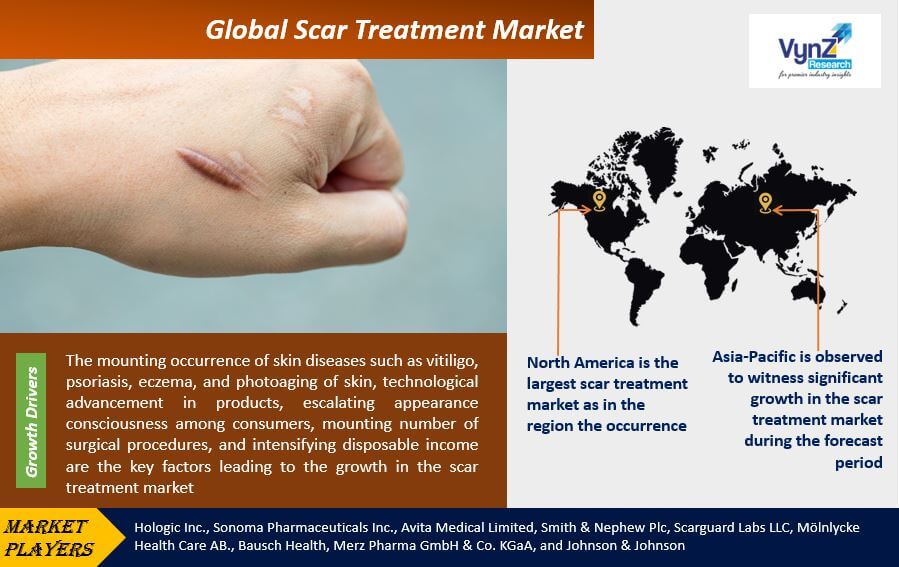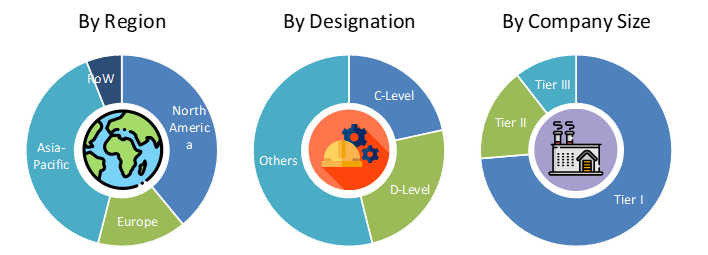Global Scar Treatment Market – Analysis and Forecast (2026-2035)
Industry Insights by Product (Surface (Chemical Peeling, Cryosurgery, and Dermabrasion), Laser (CO2 Laser, Pulsed-Dye Laser, Erbium: YAG Laser, and Others), Topical (Oil, Gel, Cream, Gel Sheet and Others), and Injectable (Dermal Filler and Steroid Injection)), and by Type of Scar (Acne Scar, Post-Surgical Scar, Stretch Mark, Contracture Scar, and Keloid and Hypertrophic Scar), and by Geography (North America, Europe, Asia-Pacific, Middle East, South America and Rest of the World)
| Status : Published | Published On : Oct, 2025 | Report Code : VRHC1110 | Industry : Healthcare | Available Format :

|
Page : 153 |
Global Scar Treatment Market – Analysis and Forecast (2026-2035)
Industry Insights by Product (Surface (Chemical Peeling, Cryosurgery, and Dermabrasion), Laser (CO2 Laser, Pulsed-Dye Laser, Erbium: YAG Laser, and Others), Topical (Oil, Gel, Cream, Gel Sheet and Others), and Injectable (Dermal Filler and Steroid Injection)), and by Type of Scar (Acne Scar, Post-Surgical Scar, Stretch Mark, Contracture Scar, and Keloid and Hypertrophic Scar), and by Geography (North America, Europe, Asia-Pacific, Middle East, South America and Rest of the World)
Industry Overview
The scar is a natural process of healing after an injury. There are different types of scars such as contracture scars, hypertrophic scars, acne scars, and keloid scars. The scar is treated with the help of over-the-counter drugs, injections, and surgical removal. The Scar Treatment Market refers to the industry involved in developing and providing products and services aimed at reducing the appearance of scars on the skin. Scars can result from various causes, including injuries, surgeries, burns, acne, and other skin conditions. Scar treatment products and services aim to minimize the visibility of scars, improve their texture, and promote skin regeneration.

The global scar treatment market is predicted to grow at 12.1% CAGR during the forecast period with the market size reaching USD 40.6 billion by 2035.
Different types of products such as surface, laser, topical, and injectable are majorly contributing to the scar treatment market size. The market has witnessed significant demand for topical over the last few years due to cost effectiveness, easy application, easy availability, fewer side effects, and greater acceptance of creams and gels for healing scars, such as burns, acne, and surgical marks.
Scar Treatment Market Segmentation
Insight by Product
Based on the product, the scar treatment market is categorized into surface, laser, topical, and injectable of which topical hold the largest share in the scar treatment market, globally, and led to the fastest growth of the topical segment during the historical period, which is also predicted to continue during the forecast period owing to greater acceptance of creams and gels for healing scars, such as burns, acne, and surgical marks, easy availability, cost-effectiveness, fewer side-effects, and easy application.
The surface segment is further subdivided into chemical peeling, cryosurgery, and dermabrasion. Among all the surfaces, dermabrasion segment accounted the largest share and is expected to grow at the fastest rate in the market. Moreover, the laser segment is further subdivided into the CO2 laser, pulsed-dye laser, Erbium: YAG laser, and others. Among all the lasers, the CO2 laser segment accounted the largest share in the market.
In addition, the topical segment is further subdivided into oil, gel, cream, gel sheet, and others. Among the topical, the cream category holds the largest share in the market. The gel sheet segment is expected to grow at the fastest rate in the market. The injectable segment is further subdivided into dermal filler and steroid injection. Among both injectables, the derma filler segment accounted the larger share and is expected to grow at a faster rate in the market during the forecast period.
Insight by Type of Scar
On the basis of the type of scar, the scar treatment market is segmented into acne scar, contracture scar, post-surgical scar, stretch mark, and keloid and hypertrophic scar. Of all, the keloid and hypertrophic scar category are predicted to witness the highest growth during the forecast period due to an escalating number of burn cases. Moreover, of all types of scar, the post-surgical scar category accounted for the largest share in the scar treatment market due to a mounting number of surgeries and an increasing number of road accidents.
Global Scar Treatment Market Report Coverage
|
Report Metric |
Details |
|
Historical Period |
2020 - 2024 |
|
Base Year Considered |
2025 |
|
Forecast Period |
2026 - 2035 |
|
Market Size in 2025 |
U.S.D. xx.xx Billion |
|
Revenue Forecast in 2035 |
U.S.D. 40.6 Billion |
|
Growth Rate |
12.1% |
|
Segments Covered in the Report |
By Product and By Type of Scar |
|
Report Scope |
Market Trends, Drivers, and Restraints; Revenue Estimation and Forecast; Segmentation Analysis; Impact of COVID-19; Companies’ Strategic Developments; Market Share Analysis of Key Players; Company Profiling |
|
Regions Covered in the Report |
North America, Europe, Asia-Pacific, Middle East, South America and Rest of the World |
Industry Dynamics
Scar Treatment Market Growth Drivers
The mounting occurrence of skin diseases such as vitiligo, psoriasis, eczema, and photoaging of the skin, technological advancement in products, escalating appearance consciousness among consumers, mounting number of surgical procedures, and intensifying disposable income are the key factors leading to the growth in the scar treatment market, globally. For instance, according to the American Academy of Dermatology, in the U.S., annually approximately 50 million Americans are suffering from acne.
Increasing Prevalence of Scars: Scars can occur due to various reasons such as accidents, surgeries, burns, acne, and other skin conditions. The rising prevalence of scars among the global population creates a significant demand for scar treatment solutions.
Growing Awareness and Demand for Aesthetic Appearance: There is a growing awareness and desire for aesthetic appearance, with individuals seeking ways to improve their skin's overall look and reduce the visibility of scars. This trend fuels the demand for scar treatment products and services.
Advancements in Scar Treatment Technologies: Continuous advancements in scar treatment technologies, such as laser therapy, microneedling, radiofrequency devices, and dermabrasion, have enhanced treatment outcomes. These innovative technologies provide more effective and efficient scar reduction solutions, driving market growth.
Increasing Demand for Non-Invasive and Minimally Invasive Procedures: Many individuals prefer non-invasive or minimally invasive scar treatment procedures over traditional surgical interventions. These procedures offer quicker recovery times, fewer complications, and less discomfort, which contributes to their growing popularity and drives market growth.
Expansion of the Cosmeceutical Industry: The cosmeceutical industry, which combines cosmetic and pharmaceutical products, has witnessed significant growth in recent years. Scar treatment products often fall into this category, offering effective solutions for scar management. The expansion of the cosmeceutical industry contributes to the overall growth of the scar treatment market.
Expansion of E-Commerce and Online Availability: The growth of e-commerce platforms has made scar treatment products more accessible to a wider consumer base. Online availability and convenient purchasing options contribute to the market's growth by reaching a larger audience and facilitating easy access to scar treatment solutions.
Scar Treatment Market Challenges
Key factors hindering the growth of the scar treatment market are the side effects of scare treatment products and therapies, and the high cost associated with scare treatment products.
Scar treatment procedures and products can be expensive, especially advanced treatments such as laser therapy or surgical interventions. The high cost can restrict access to scar treatment for individuals with limited financial resources, limiting market growth and adoption.
The scar treatment market is subject to regulatory oversight to ensure the safety and efficacy of products and procedures. Obtaining regulatory approvals and meeting compliance requirements can be time-consuming and expensive, creating barriers to entry for smaller market players and hindering innovation.
Recent Developments By the Key Players
Hologic has acquired Gynesonics, a company specializing in minimally invasive solutions for women's health. This acquisition enhances Hologic's portfolio with the Sonata System, offering advanced treatment options for uterine fibroids.
Sonoma successfully transitioned four products to the new European Union Medical Device Regulation, achieving Class IIb medical device classification for Microdacyn60® Wound Care, Microdacyn60 Hydrogel, Epicyn® Scar Gel, and Pediacyn® for atopic dermatitis.
Scar Treatment Market Geographic Overview
Geographically, North America is the largest scar treatment market as in the region the occurrence of skin disease is increasing. In addition, mounting disposable income, a large number of players in the U.S. are focusing on R&D to introduce new products and technological advancements in treatment products are also fueling the growth of the North American scar treatment market.
Global Scar Market Share, By region
Asia-Pacific is observed to witness significant growth in the scar treatment market during the forecast period, as the region comprises a large population. Moreover, mounting disposable income, mounting healthcare expenditure, improving healthcare infrastructure, expanding awareness regarding the treatment of scars, and escalating skin related problems are also facilitating the significant growth of the Asia-Pacific scar treatment industry.
Scar Treatment Market Competitive Insight
Market players in the scar treatment industry are investing capital to develop technologically advanced systems.
Some of the key players offering solutions for scar treatment are:
- Hologic Inc
- Sonoma Pharmaceuticals Inc
- Avita Medical Limited
- Smith & Nephew Plc
- Scarguard Labs LLC
- Mölnlycke Health Care AB
- Bausch Health
- Merz Pharma GmbH & Co. KGaA
- Johnson & Johnson
The Scar Treatment Market report offers a comprehensive market segmentation analysis along with an estimation for the forecast period 2026–2035.
- By Product
- Surface
- Chemical Peeling
- Dermabrasion
- Cryosurgery
- Laser
- CO2 Laser
- Erbium: YAG Laser
- Pulsed-Dye Laser
- Others
- Topical
- Cream
- Gel Sheet
- Gel
- Oil
- Others
- Injectable
- Dermal Filler
- Steroid Injection
- Surface
- By Type of Scar
- Acne Scar
- Stretch Mark
- Post-Surgical Scar
- Contracture Scar
- Keloid and Hypertrophic Scar
Scar Treatment Market by Region
- North America
- U.S.
- Canada
- Mexico
- Europe
- Germany
- U.K.
- France
- Italy
- Spain
- Rest of Europe
- Asia-Pacific
- Japan
- China
- India
- Australia
- South Korea
- Rest of Asia-Pacific
- Rest of the World
- Brazil
- South Africa
- Saudi Arabia
- U.A.E
- Other Countries
PRIMARY RESEARCH INTERVIEWS - BREAKDOWN

Frequently Asked Questions
Purchase Options
Latest Report
Research Methodology
- Desk Research / Pilot Interviews
- Build Market Size Model
- Research and Analysis
- Final Deliverabvle
Connect With Our Sales Team
- Toll-Free: 1 888 253 3960
- Phone: +91 9960 288 381
- Email: enquiry@vynzresearch.com
Scar Treatment Market
